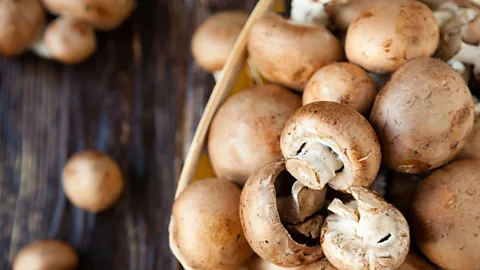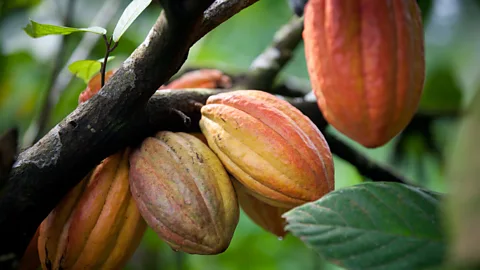
 Getty Images
Getty ImagesIt has all the makings of a delicious smoothie – a dollop of almond butter, an avocado, a few slices of mango, a handful of blueberries, a sprinkle of cocoa powder and perhaps a glug of soya milk.
As a tasty, vegan-friendly drink to start your day, it is packed with nutrients and will do wonders for your health. But it may be doing far less good for the planet.
“Nothing really compares to beef, lamb, pork, and dairy – these products are in a league of their own in the level of damage they typically do to the environment, on almost every environmental issue we track,” says Joseph Poore, a researcher at the University of Oxford who studies the environmental impacts of food. “But it’s essential to be mindful about everything we consume: air-transported fruit and veg can create more greenhouse gas emissions per kilogram than poultry meat, for example.”
Delicate fruits like blueberries and strawberries, for example, are often imported to Europe and the US by air to fill gaps left when local fruit are out of season. Research by Angelina Frankowska, who studies sustainability at the University of Manchester, recently found that asparagus eaten in the UK has the highest carbon footprint compared to any other vegetable eaten in the country, with 5.3kg of carbon dioxide being produced for every kilogram of asparagus, mainly because much of it is imported by air from Peru. She and her colleagues found, in fact, that the succulent green stalks have the largest environmental footprint of any of the 56 vegetables they looked at, including its land use and water use (which was three times greater than the next highest).
More from The Vegan Season on BBC Good Food
Without carefully considering where our food comes from and how it is grown, our diets can have unintended consequences. Take the strange case of two vegans in an Italian study who were found to have an environmental impact considerably higher than many meat-eaters. When the researchers dug a little further, they discovered the pair exclusively ate fruit.
“They ate a huge quantity of fruits,” explains Francesca Scazzina, an expert on human nutrition at the University of Parma, Italy. “In fact, I remember [it was] 7-8kg (15.4 to17.6lb) per day of fruit. We collected their data in the summer so they especially ate watermelons and cantaloupes.”
The water, land and carbon footprint of growing and transporting such large, perishable fruit meant the environmental impact was far larger than they had expected. Once the data from all 153 vegans, vegetarians and omnivores in the study was taken into account, however, it showed that eating meat was on average worse for the environment.
 Getty Images
Getty ImagesBut there are other general points to consider when we think about food crops that can drive up the environmental impact. Artificial fertilisers, for example, account for at least 3% of global greenhouse gas emissions, according to the industry. The production of synthetic fertiliser emits carbon dioxide (CO2) and methane into the atmosphere, while their use on fields releases nitrous oxide, another potent greenhouse gas.
These all combine to differing degrees depending on the crop, but there are clearly some plant-based foods that have a disproportionate impact on the environment. Here BBC Future takes a look at some of the worst offenders:
The rich green flesh of this fruit is being smashed, blended and chopped in hipster cafes, smart restaurants and home kitchens around the world. Avocadoes can be an important source of protein, vitamins and fatty acids for people cutting out meat from their diet.
But they also guzzle up huge amounts of water. A single mature tree in California, for example, needs up to 209 litres (46 gallons) every day in the summer – more than would fill a large bathtub. It is a staggering amount in the dry summer months in water-stressed regions such as California, Chile, Mexico and southern Spain, where many commercial avocado crops are grown, and puts huge pressure on the local environment.
There is cause for hope though – one farmer in California claims to have reduced the amount of water he uses by 75% thanks to wireless soil moisture sensors that monitor the ground around his trees and ensure the precious liquid is only delivered where and when it is needed.
After harvesting, however, some avocadoes and mangoes are also bathed in hot water for over an hour to prevent insect infestations and control decay. Their highly delicate flesh and rapid ripening also means that much of the fruit imported to Europe and the US is flown there by air.
 Getty Images
Getty ImagesTogether with the amount of waste, special storage conditions and packaging needed for avocados, this helps to give the fruit a hefty carbon footprint – the equivalent of 2.2kg of CO2/kg for avocados imported to the UK according to one study. It also estimated mangoes emitted 4.4kg of CO2/kg.
A detailed analysis by researchers at the University of Michigan’s Center for Sustainable Systems, however, which gathered data from around the world and takes into account other aspects of food such as packaging and the amount of waste created during production and transport, puts the global carbon footprint of avocados at 0.55kg of CO2/kg while mangoes come out at just 0.6kg of CO2/kg. These figures may be lower because not all countries have to freight their fruit by air to get it fresh.
And from a climate change point of view, they make an ideal meat replacement, producing just a fraction of beef’s emissions. But for a crop that flourishes without light by feeding on rotting organic waste, they can have a surprising impact.
Most of the emissions come from the energy needed to keep the rooms where mushrooms are cultivated warm. Growing rooms and compost need to reach temperatures of up to 62C, depending on the system being used, in order for the mushrooms to grow.
Analysis by the University of Michigan found cultivated mushrooms produced 3kg of CO2/kg on average. Still far less than beef. And less than the “greenest” farmed meat – chicken – which produced 4.1kg of CO2/kg by their calculations. But it came out the same as saltwater fish and more than tuna, which release 3kg of CO2/kg and 2.2kg of CO2/kg respectively. Of course, fishing has its own environmental and biodiversity issues on top of that, though.
 Getty Images
Getty ImagesOne further consideration is the use of peat in many of the composts used by the mushroom industry. Unless extracted sustainably, this can damage delicate bog ecosystems and deplete their ability to store carbon in the future.
But there are hopes that by using more food and agricultural waste to create sustainable compost substrates for mushrooms to grow in, using the material left after harvesting to make biodegradable packaging, and piping carbon dioxide into greenhouses to grow plant-based crops, it may be possible for mushrooms to become truly green.
Another popular meat substitute grown from fungi, mycoprotein has some surprising environmental impacts. Making it uses a fraction of the land compared to chicken, pork or beef, but the carbon footprint is estimated to be 5.55-6.15kg CO2/kg by one study. More than half of this, however, comes from processing after the fungi produces the protein – some vegetarian mycoprotein products, such as mince, are combined with egg white to bind it together. Fertiliser is also needed to grow sugar the fungi feeds on, which accounts for 11% of the emissions.
The company says it hopes that by publishing the information it can help its customers make informed decisions about what impact the food they eat is having on the environment, and has called on other brands to follow its example.
It may have developed something of a reputation as a health food in recent years, but cocoa and raw cacao products have a dark side when it comes to the environment.
“Cocoa is also a major driver of tropical deforestation and one of the biggest contributors to global biodiversity loss after beef, pork, and poultry meat,” says Poore. Exact figures for how much forest is being lost due to cocoa production are hard to pin down, but it is estimated that 2-3 million hectares (4.9-7.4 million acres) of tropical forests were lost to cocoa plantations between 1988 and 2008.
 Getty Images
Getty ImagesThen there is the carbon footprint of cocoa and its associated with products. The University of Michigan’s analysis found that 1kg of chocolate produces on average the equivalent of 11.2kg of CO2, while 1kg of cocoa powder would release 33.6kg of CO2.
But Poore says that the amount of greenhouse gases released by products like chocolate can vary wildly. His own detailed research has shown that a small 50g bar of dark chocolate can create up to 7kg of CO2 emissions in extreme cases – the equivalent of driving around 17 miles in the average American car. That’s more than 250kg of CO2 for every kilogram of dark chocolate. But he and his colleagues also found some dark chocolate can actually have a positive effect on the climate because the trees pull carbon out of the atmosphere. The main reason for the variation stems from whether rainforest was cut down to make way for the crop.
“Two products that look exactly the same in the shops can have dramatically different impacts on the environment and today we have no way of telling them apart,” says Poore.
He believes better information on product packaging could help consumers, whether vegan or not, to keep their carbon footprint low by choosing low-impact foods.
Tree nuts in general are perhaps the anti-heroes of the vegan diet. They are packed with valuable nutrients and proteins, yet they arguably take more than their fair share of environmental resources.
Almonds, he says, need comparatively large amounts of water, pesticide and fertiliser, which makes their environmental impact disproportionately large. One study, funded by the Almond Board of California, found that the average almond grown in the US state requires 12 litres of water, or 10,240 l/kg of kernels.
 Getty Images
Getty Images“Almonds have a high water footprint in part because they are a thirsty crop and also have high fertiliser inputs, but also because they are a dense product,” says Julian Fulton, an environmental scientist at California State University, Sacramento, who led the study. “Only a small part of the almond fruit is harvested and it’s dry, so all that water went into producing a more compact product.”
“For consumers wishing to get the most nutrition ‘bang’ for their water ‘buck’, almonds end up looking pretty good especially for sourcing things like protein and calcium.”
Of all the nuts, however, the University of Michigan estimates that cashews release the most carbon – 4.99kg of CO2/kg by his calculations. This may partly be because they are a low-yield crop. Newly harvested cashew nuts are also encased in layers of hard shell, in between which is a caustic oil which can burn the skin of people handling them. During processing this oil is often extracted but needs careful handling to ensure it doesn’t escape into the environment.
What is clear is that while plant-based foods and meat substitutes can be far better for the environment than livestock production as a whole, if we really want to make a difference to the environment we need to take care about what we choose to replace meat with.
Sticking to locally produced fruit and vegetables that are in season is the best approach, says Scazzina.
“My general recommendations end up being, reduce meat consumption, and pay attention, if you can, to how foods are grown and transported,” adds Martin Heller, a sustainability researcher who led the University of Michigan study. “Try to avoid heated greenhouse grown fruit and veg, and stuff that may have been air freighted.”
